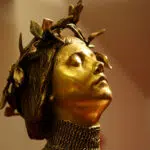Joan of Arc, also known as Joan the Maiden and The Maid of Orleans, is known in history as a saint by the Roman Catholic Church and a heroine of France because of the role she played during the Lancastrian phase of the Hundred Years’ War. Joan believed that she had seen visions from the Archangel Michael, Saint Margaret, and Saint Catherine of Alexandria to assist King Charles VII to recover France from England’s dominance. After several pleas to see the king, she was allowed to meet with King Charles VII at Chinon. The king allowed her to the Siege of Orleans as part of the relief army in April 1429. She ended up winning the war for King Charles and was by his side when he was consecrated. What an honor to be celebrating Joan of Arc the martyr and heroine with the world today.
Fast Facts
Nickname:
The Maid of Orleans, La Pucelle
Birth date:
January 6, 1412
Death date:
May 30, 1431 (age 19)
Zodiac Sign:
Capricorn
Height:
5' 6"
Relationship Status:
N/A
Background
Joan of Arc, born around 1412, came from a small village in the Meuse Valley known as Domremy located in Lorraine, France. Her parents, Jacques d’Arc and Isabelle Romee were peasant farmers who owned around 50 acres of land. Her father also worked as a village official for more income. She did not attend school but her mother ingrained the Catholic church teachings. At the time, France had conflicted with England in a war known as the ‘Hundred Years’ War. As a teenager, she believed she had a vision from the Archangel Michael, Saint Margaret,’ and Saint Catherine of Alexandria to assist King Charles VII to recover France from England’s dominance.
The king sent her to the Siege of Orleans as part of the relief army in April 1429. Nine days after arriving in Orleans she lifted the siege and that gave her recognition. Afterward, King Charles VII was consecrated and she was there by his side. On September 8, Joan of Arc and John II, Duke of Alencon attacked Paris but failed and Joan was wounded. By October she was well and went to war again with Perrinet Gressart and although they lost, she returned home to find her family had been raised to the nobility by King Charles VII. In May 1430, she put together a team of volunteers to take over from Compiegne, which had been attacked by Burgundians but instead they captured her and gave her away to the English.
She was tried by the Pro-English Bishop at the time, Pierre Cauchon on charges of hearsay and found guilty. Her judgment was to burn at the stake which happened in May 1431. In 1456, however, her case was authorized by Pope Callixtus III to be reopened and investigated It was discovered that it was deceitful and ill-considered and therefore nullified. Her name was written off any blemish and she has been esteemed as a martyr since. She went on to become a national symbol of France after the revolution.
Career timeline
King Charles VII decides to send Joan of Arc to the Siege of Orleans as part of the relief army.
The prior victories she has from previous wars pave the way for the final French victory in the Hundred Years’ War at Castillon.
She organizes volunteers to go with her to mitigate Compiegne that was attacked by Burgundians.
The Pro-English Bishop, Pierre Cauchon, puts Joan on trial for heresy and sentences her to burn at the stake.
Pope Callixtus III orders the reopening of the case, nullifies the charges, and Joan’s name is cleared.
After the French Revolution, she becomes a symbol of France — she is canonized and is later declared a patron saint.
Why We Love Joan of Arc
She was a heroine
Joan of Arc was a brave military leader. She is also described as a woman who fought for what she believed in and inspired others to do the same. She is compared to biblical women like Esther and Judith.
She was a saint and a martyr
Joan of Arc’s religious figure was recognized by the people of Orleans. When Felix Dupanloup became Bishop in 1942, he initiated her beatification. At the time of her death, she was already acknowledged as a martyr and a religious figure that went beyond the Catholic Church. She is also a visionary in The Church of England and is cherished as the Pantheon of the Cao Dai religion.
Her rich cultural legacy
Hundreds of works of art depicting Joan of Arc have been generated in France. She has gone on to be the topic of so many books. Her legacy is global and her story has inspired all forms of art and literature over the years all over the world.
5 Surprising Facts
She’s been diagnosed with a mental disorder
Joan of Arc is said to have had a neurological imbalance that eventually resulted in bipolar disorder or schizophrenia at the time of her visions.
The first woman to sport the ‘bob’
People who told her to wear male clothing during war also asked her to wear her hair short so she cut it out into a ‘bob’ and that was the hairstyle she was captured in.
Her brothers passed imposters off as her
Setting out to convince the world that Joan had escaped and the English had not won, her brothers passed off Joan imposters for a number of years.
Joan of Arc had many names
Before her trial, Joan noted her name as Jehanne la Pucelle and in her town, she was known as Jeanette but Arc became the adaptation of what her father’s name was.
Her ashes were scattered into the Seine
It is believed that her remains were scattered into the Seine and that her spirit still moves with water to date.
Joan of Arc FAQs
Why did they shave Joan of Arc’s head?
Cauchon announced that Joan would be welcomed back to the church and her soul would be saved, but she would live the rest of her days in prison in penance for her sins. Joan was escorted away, given a dress to wear and her hair was shaved.
What did Joan of Arc say when she died?
To the end, she continued to claim that the voices she had heard all her life were divine. She called on her three favorite saints for help as she burned. Right before she lost consciousness, she yelled out “Jesus!”
Where is Joan of Arc’s sword?
Legend has it that Joan of Arc’s holy sword was found buried behind the altar of the church of Saint Catherine de Fierbois. It was old and rusted with five crosses on the blade. The sword was refurbished and sent to her.
Joan of Arc’s birthday dates
| Year | Date | Day |
|---|---|---|
| 2026 | January 6 | Tuesday |
| 2027 | January 6 | Wednesday |
| 2028 | January 6 | Thursday |
| 2029 | January 6 | Saturday |
| 2030 | January 6 | Sunday |
















